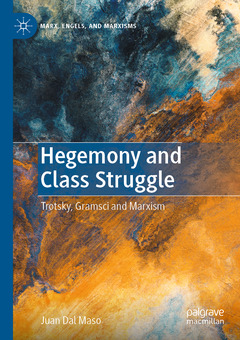Hegemony and Class Struggle, 1st ed. 2021 Trotsky, Gramsci and Marxism Marx, Engels, and Marxisms Series
Auteur : Dal Maso Juan

Leon Trotsky and Antonio Gramsci are two of the most important Marxist thinkers of the 20th century. This book explores the similarities and the differences between their philosophical and political theories. The first and second chapters deal with a still under-investigated aspect of Trotsky?s thought, i.e. his reflections on the issue of hegemony. The third chapter focuses on Gramsci?s critique of Trotsky in his Prison Notebooks, analysing Gramsci?s knowledge of Trotsky?s positions as well as the scope and limits of Gramsci?s critique. The fourth chapter consists of a critical rereading of Perry Anderson's essay Antinomies of Antonio Gramsci, originally published in 1976 and republished in 2017 and an analysis of the book Gramsci and Trotsky in the Shadow of Stalinism by Emanuele Saccarelli. The result is an investigation that offers new insight into both Trotsky?s and Gramsci?s thought, while proposing a new point of view from which to interpret revolutionary theory and strategy in the contemporary scenario. One of the main topics addressed throughout the three essays is the specific position of the problem of hegemony in a theory of permanent revolution, demonstrating that Trotsky had a particular understanding of the question of hegemony and that Gramsci, in turn, introduced a concept of hegemony that is closely associated with an idea of permanent revolution, such that the dynamics of the relationship between democratic struggles and socialist struggles presented in both theories are very similar.
Offers a unique analysis of Trotsky’s conception of hegemony.
Gramsci’s opinion of Trotsky’s work has thus far been neglected by both Trotsky and Gramsci scholars.
This book remedies this deficiency and transcends the boundaries of scholarly works on these authors.
Attempts to offer a “third position” between that of Anderson (which is widespread in anglophone academia) and that of Francioni (which is at the basis of the Gramsci renaissance in Italy) in understanding Gramsci
Date de parution : 06-2022
Ouvrage de 221 p.
14.8x21 cm
Disponible chez l'éditeur (délai d'approvisionnement : 15 jours).
Prix indicatif 89,66 €
Ajouter au panierDate de parution : 06-2021
Ouvrage de 221 p.
14.8x21 cm
Disponible chez l'éditeur (délai d'approvisionnement : 15 jours).
Prix indicatif 126,59 €
Ajouter au panierThèmes de Hegemony and Class Struggle :
Mots-clés :
Hegemony; Class; Trotsky; Gramsci; Marxism; hegemonic power; Soviets; Lenin; Stalin; USSR; depoliticization; communism; state; democracy; fatalism; activism; revolution; democratic struggle; socialist struggle



